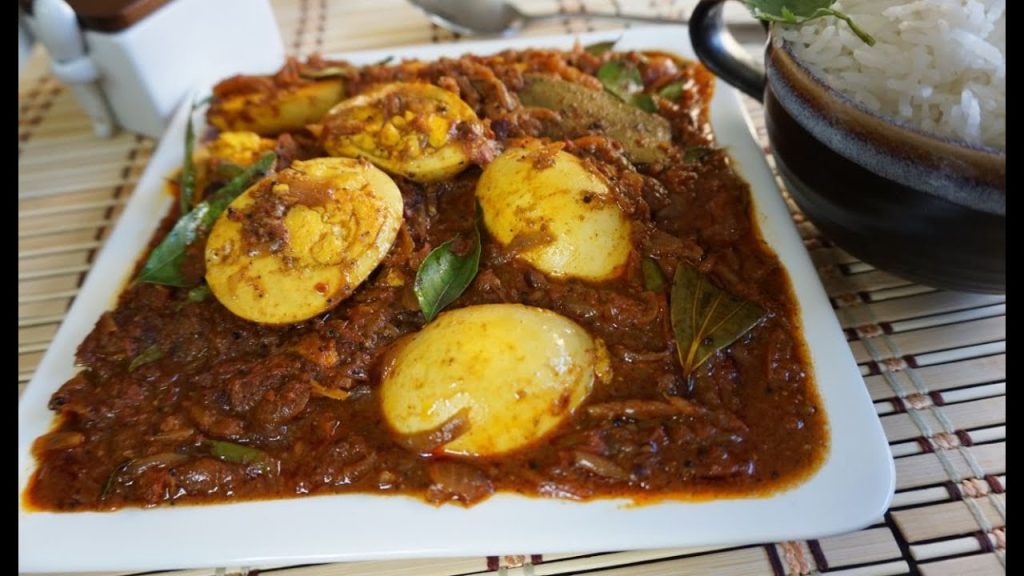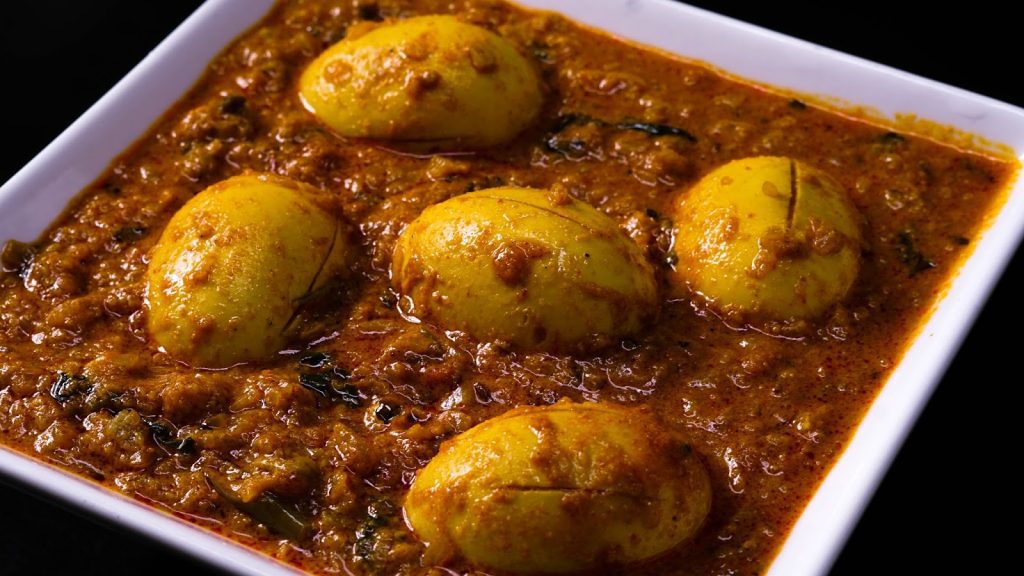Learn about How to prepare Chettinad Egg Curry. Learn how to prepare Chettinad Egg Curry with a flavorful blend of spices, coconut, and hard-boiled eggs for a spicy, aromatic dish.
Introduction
The recipe for the Chettinad Egg Curry is known to be both mouth-watering and wholesome in One system for foodies. This curry is centered around hard-boiled eggs that are soaked in a thick spicy tomato curry containing various spices some of which include fennel, black pepper, cinnamon, and curry leaves. To thicken The Chilli and black pepper heat, coconut is used to add some creaminess.
Freshly grounded Chettinad masala blend made entirely from dry spices lifted the hotness of the roasted tomatoes in the curry to another level. Other ingredients such as tomatoes, garlic, ginger, and onion made the flavor of the curry even more pronounced. This curry is usually consumed with rice dosa, or Lachedar paratha, this dry curry can be easily dubbed as a spice heaven for people willing to indulge in authentic flavors of the Chettinad region.

History of Chettinad Cuisine
The Chettinad people are the Chettiar clans that are most prominent in trade activities and known as gourmet cooks. Chettinad food evolved round after round as Chettiar people traveled throughout Southeast Asia, Sri Lanka, and many other countries. Varying formulas can create meals that go beyond mixing flavors. One of the richest egg curry recipes, it uses a concentration of spices that is dominated by high-quality black pepper, star anise, and dried red chili peppers, making the dish taste very flavorful.
Advantages of Chettinad Egg Curry
1. Protein
In the Chettinad Egg Curry, the eggs provide a good source of protein which promotes muscle growth, boosts immunity, and gives energy. Moreover, being rich in protein, this egg curry with well-spiced gravy also serves those wishing to increase their protein intake, for protein is responsible for tissue repairs.
2. Calcium
Eggs are rich in calcium which helps to keep the bones and teeth strong. Also, coconut milk is frequently used in Chettinad Egg Curry enhances the calcium content. Therefore this makes the dish not only appetizing but also aids in bone health, particularly for people who wish to consume more calcium-rich food naturally.
3. Vitamins and Minerals
The dish is rich in many essential vitamins like B6, and B12, and also high in several minerals such as iron, and zinc, among others. These nutrients are important for energy metabolism and the immune system, which is why succulent Chettinad Egg Curry can be an appropriate filling meal for one’s diet.
4. Vitamin D
Provitamin D is found in its natural form in food – chicken eggs. It is responsible for bone health primarily and also helps to boost the immune response. Since there is very little availability of dietary sources of this vitamin, the dish Chettinad Egg Curry is yummy but equally healthy and promotes Vitamin D levels, especially for those who have lesser sun exposure.
5. Fresh Spices
Chettinad Cuisine is characterized by the use of spices such as turmeric, cumin, or black pepper, besides flavoring dishes prepared herein. They have a medicinal quality also. Spices are all antioxidants and antifungals which reduce inflammation while helping digest food and even fight infections. The use of various spices gives a distinct lady-like quality to the dish.
6. Texture
The richness of the dish comes from the use of both boiled eggs and poured coconut milk, thus it is filling. The creamy dish beautifully enfolds the eggs in its thick gravy making it very enjoyable to eat. In addition to that, a rib-sticking dish Chettinad Egg Curry is also enjoyed with rice or bread as it is mild spicy with creamy texture.
How to prepare Chettinad Egg Curry?
Key Ingredients in Chettinad Egg Curry
A variety of ingredients contribute to the curry’s signature taste. Here’s a breakdown:
- Hard-boiled eggs: As the main elements of the recipe, the eggs are cooked, after which they are deep fried or dry cooked to marinate in spices.
- Chettinad masala: An array of spice mixes containing white pepper, fennel, coriander, cumin, cinnamon, clove and anise powders. These spices are usually first toasted in a pan, and then ground into powder.
- Onions, tomatoes, and garlic: These are the ones that prepare the gravy and also add body and taste to the dish.
- Curry leaves: Curry leaves also known as sweet neem leaves are an important part of South Indian dishes and add an aromatic flavor to the curry.
- Coconut: Coconut makes this curry more convenient – both in the shredded as well as the reconstituted coconut milk forms
- Tamarind or lemon juice: Lastly, to make the mix sour, tamarind or lemon is sprinkled to give a wet sour taste which balances the spices.
3. Step-by-Step Recipe for Chettinad Egg Curry
Here’s a simple yet authentic recipe for preparing this dish at home.
Ingredients:
- 4-5 hard-boiled eggs
- 2 medium onions, finely chopped
- 2 tomatoes, finely chopped
- 1 tbsp ginger-garlic paste
- 2-3 green chilies (optional for extra heat)
- A handful of curry leaves
- 1/2 cup grated coconut or 1/2 cup coconut milk
- 1/2 tsp turmeric powder
- Salt to taste
- Oil for frying
For Chettinad Masala:
- 1 tsp black peppercorns
- 1 tsp fennel seeds
- 1 tbsp coriander seeds
- 1/2 tsp cumin seeds
- 2-3 dried red chilies
- 1 small piece of cinnamon
- 3-4 cloves

Instructions:
1. Prepare the Masala
Add all the whole black pepper, fennel, coriander, cumin seeds, dry red chilies, cinnamon, and cloves in a cast-iron pan over medium flame. Add the spices until the aroma rises. When this mixture cools down a bit, grind it to a fine paste.
2. Boil the Eggs
Boil water in a pot, then lower the eggs into the boiling water and let them stay there for 10 minutes. Allow cooling and peeling, the eggs can further be fried which will give a crispy golden crust to the eggs outside.
3. Prepare the Curry Base
In a saute pan, pour oil and when it is hot add a few curry leaves. Partially fry the onions until they turn golden, after which ginger-garlic paste is added and stirred until the raw smell disappears.
4. Add Tomatoes and Spices
Add diced tomatoes, turmeric powder, and salt. Stir to mix and cook until the tomatoes are soft but not mushy and the mixture begins to separate from the oil.
5. Mix in Coconut
Add grated coconut or coconut milk, allowing the curry to get thick. Alternatively, stir for a couple of minutes until the thick gravy is quiet.
6. Add Eggs and Simmer
Introduce the boiled eggs and the grounded Chettinad masala. Cook on low flame for 10-15 Minutes so that the eggs are well covered with the taste.
7. Final Touches
If necessary adjust the salt and spiciness, optionally put a splash of lemon juice or tamarind water to make it slightly sour.
4. Serving Suggestions
Chettinad Egg Curry pairs beautifully with several South Indian staples:
- Steamed rice: This is served customarily, offering soothing relief from the strong taste of the curry.
- Paratha or chapati: The crispy, layered flatbread called paratha or the buttery soft chapatti when paired with the rich curry creates an interesting contrast.
- Dosa or appam: The slightly sour taste of these fermented rice-based accompaniments helps to alleviate the hotness of the curry.
Few considerations to keep in mind when preparing Chettinad curry
Even though Chettinad Egg Curry is a famous dish, there are several aspects that one has to bear in mind while making this dish:
- Spices: Chettinad curry is spicy because its combination of spices is very rich but would mostly upset people who are not used to eating such fattening food. However, this does not mean that the excessive use of black pepper and Achilles can’t be done in order not to alter the original cuisine.
- Fenugreek: If used abundantly, fenugreek seeds will impart bitterness which will interfere with the balance of the curry. Correct that by dispensing just enough earthy flavor-wise. To replace the flavor and prevent the aftertaste from being harsh, toasting them slightly before incorporating other ingredients works.
- Coconut: A prominent feature in Chettinad dishes is coconut milk, which helps to make the food creamy and rich. On the other hand, excessive amounts of coconut may inhibit the other spices. A small amount of grated coconut or coconut extract is advantageous in achieving a pleasant and even taste.
- Poppy Seeds: Poppy seeds give depth and nutty flavor, however, excessive use of poppy seeds can make the curry too heavy. Poppy seeds need to be ground very finely to prevent any grittiness in the dish and then used sparingly to add texture to the dish without dominating the other flavors.
- Smoothness: The right texture is very important. The curry must be smooth, thick enough to cling to all the spices around the eggs, and should not break when the eggs are coated inside. Avoid any lumps by properly incorporating the mixture and when the dish is called, cook it until the curry becomes thick and creams without any separate floating flavors.
Tips for Perfecting Chettinad Egg Curry
- Use fresh spices: The use of freshly ground spices provides Chettinad Egg Curry with an authentic smell and an, even more, rich taste. This guarantees the toasted spices’ a very strong masala which makes it appealing to the audience and cooks the dish enhances the fragrance even more making sure it is impossible to resist the dish.
- Adjust spice levels: Most people are familiar with the fact that Chettinad food is very hot and spicy, hence modify the number of chilies as per your tolerance. Heat is often retained in traditional recipes however here it can be lessened by the use of fewer chilies or even changing them to less hot variety without any adverse effects on the flavor of the curry.
- Don’t skip the curry leaves: No dish is complete without curry leaves, if one is looking for a dish with authentic taste and aroma. Fresh curry leaves are the best as they add a lovely fresh citrusy flavor, though, where fresh ones are not available, dried leaves may be used. Adding them at the beginning of the cooking process enables the very distinctive flavor to infuse well into the curry.
- Allow flavors to meld: Allowing the curry to cook for a longer time is aimed at allowing the spices to soak into the eggs thus bringing out more flavor. As the ingredients cook together in a process known as composting, the spices marry, and a single flavor develops. Extending the cooking time results in the improvement of the consistency and texture of the curry, thus producing a rich flavorful curry.
Flavor Profile and Serving Suggestions
Chettinad Egg Curry appeals to diverse tastes on the tongue. The spiciness not only provides warmth but also adds complexity to it, which, when combined with coconut milk and eggs, creates a perfect balance. The dish is specifically made for people who like strong taste and warmth in the food. While the curry is rich and flavorful, it also goes well with steamed rice or soft dosas, making an authentic resort to meals where rice is served without sauce and soaked up the flavorful curry.

Conclusion
Chettinad Egg Curry is one of the fascinating South Indian dishes that use the traditional cuisine and cooking methods of the Chettinad region. It is a dish that contains a rich and thick aromatic gravy made of spices with protein-filled eggs. Well, Chettinad Egg Curry is a meal that is hearty enough for spice eaters whenever served with rice dosa or even a paratha. Cooking this curry brings the beauty of Chittagong cuisine right into your kitchen.